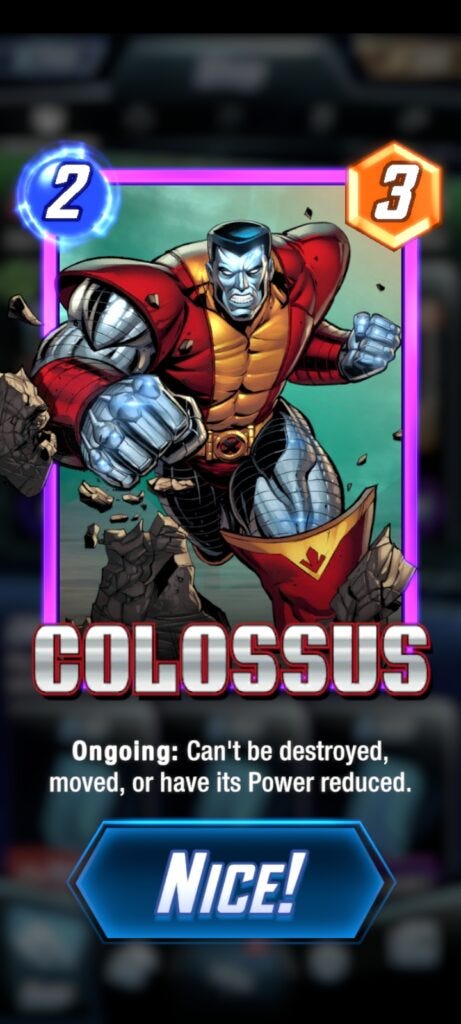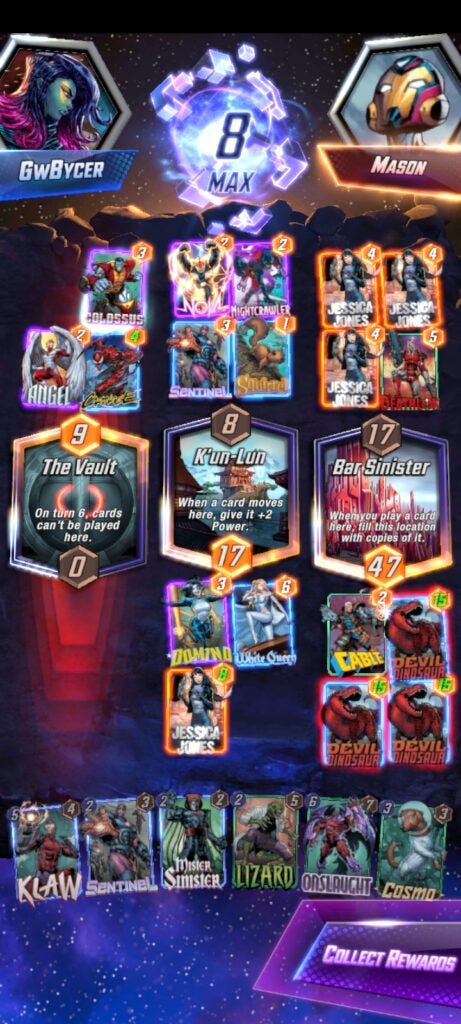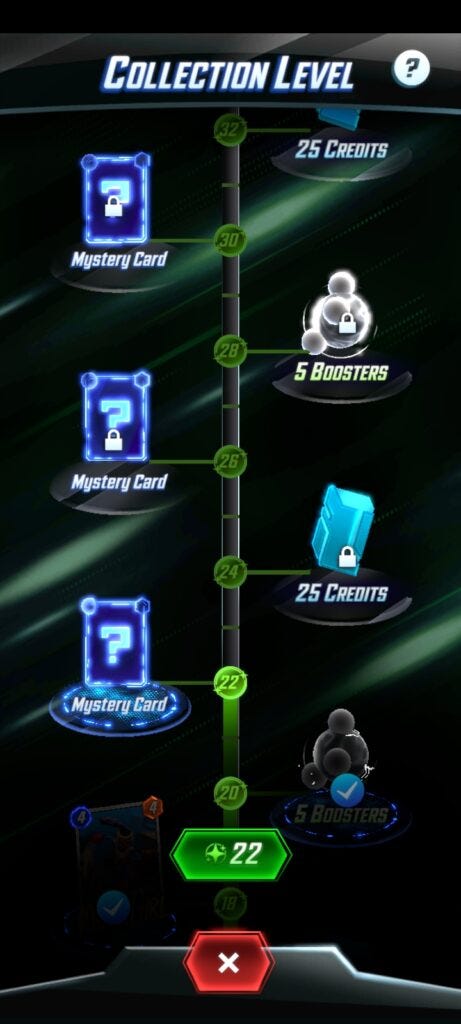Marvel Snap Is a Surprising CCG…Until It’s Not
A slow and snappy game

Marvel Snap was launched last week as the latest game from Ben Brode, previously of Blizzard. While there, Brode was one of the driving forces behind Hearthstone — a massively successful Collectible Card Game (CCG) that aimed to reduce the complexity and onboarding of the genre. With Marvel Snap, he and his team are at it again with an even more stripped-down take on CCG design, but while this game starts off strong, you’re going to need more than a snap if you want to stay successful.
A Multiverse of Multiplayer
There isn’t really a story to be found in Marvel Snap, and what is there simply serves as a way of having all your favorite, least favorite, and unknown, Marvel characters come together for a CCG. I really like the aesthetics of the cards, as they use different comic book styles and every character has their own unique font that goes with them. This also becomes a point when it comes to card upgrading that I’ll come back to in a minute.
As of launch, there is only the standard mode of 1v1 against random opponents to play. From there, wins and completing daily quests will allow you to unlock progress in the season pass and raise your collection levels which are the primary forms of progression. Before we talk about that, let’s discuss the card dynamics themselves and how Marvel Snap is designed around “snappy” gameplay.
Streamlined Superheroes
Marvel Snap follows in the footsteps of Hearthstone as a game that was built to avoid the fluff and overly long scenarios that can happen with CCGs/TCGs. Decks are only 12 cards big and matches only go to six turns by default. With both players starting at 1 energy, this means card balancing and dynamics are more polarizing compared to other card games.

Because you will only have six energy, which is the highest cost for a card at this time, for one turn, it means that those cards are often very swingy in terms of their abilities, and you can’t build a deck around more than 2 to be on the safe side.
Of all the CCGs/TCGs I’ve played lately, Marvel Snap is by far the least complicated to learn. Many cards will fall into one of many different strategies or card effects like destroying cards, adding cards to your hand, messing with the opponent, and so on. With only 12 cards in a deck, it means that the strategies in this game are laid out very simply in terms of what cards fit where, and there isn’t a lot of room to add in other cards.
The real X factor for what happens in a game is the board itself. Every match is played on a three-lane structure with three locations to put cards in. Those locations are randomly chosen at the start of the match and can do everything from doubling card effects to adding more turns to the match, and more. Winning or losing a match will provide you with “boosters” for specific cards you used, which takes us to how progression works.
Presentation Progression
Instead of having an account level based on your win rate, Marvel Snap instead has a “collection level” that represents the number of cards you have and their overall state. Once you have enough boosters on a card, you can consume them and credits (the free currency) to upgrade the look of the card. These upgrades do not impact the performance in any way but will add more graphical and aesthetic details to the card. I really like this and how the game uses comic book art to great effect.
The more you upgrade your cards, the higher your collection level will go. For every four levels you gain, you will receive a random card. It has been determined that players starting out will only go up against bots for several dozen levels, so at this time I’m not sure just how strong my decks are.
At this moment, the only use for gold (the premium currency) is to buy graphical variants of cards you own, refresh daily missions, and get more credits.
There is a ladder ranking based on wins, which to the game’s credit, it does do something differently. During a match, you can gamble, or “snap” to bet more on the match that you will win. If you win, you’ll go up the ladder faster, if you lose, you’ll drop down faster.
The other aspect of the game, and where you’ll be spending the most money, is with the season pass structure.

Sensational Seasons
While you can spend premium currency to unlock new cosmetics, the real money drain with Marvel Snap is with its season passes. Every month, you can buy the season pass for $9.99 at the basic tier. Doing so will give you guaranteed access to a card, an exclusive variant of the card, and access to additional exclusive variants if you go up the season pass.
This is the only way in the game now that you can guarantee access to specific cards. Free players can go up the season pass as well, but most of the rewards will be locked to them.
Because this game doesn’t feature expansions or booster packs, the developers are planning on releasing a few new cards each month instead of dropping a lot of them at a time. This feeds into the more casual atmosphere of the game, and I do like that progress is tied to games played, not to wins. However, for fans looking for more here, you may be disappointed as you climb up your collection.
A Short Series
Looking at Marvel Snap compared to the other CCGs/TCGs I covered in my next book, it is by far the most welcoming to players who have never touched a card game before. I would highly recommend this game if you are looking for a starter CCG to play.
However, for fans looking for more depth to the games and cards, there are several limitations built into the game itself. The small deck sizes and the designs of the cards limit the variety of ways you can play at this time. If you want to go for an “on active” deck, or a “destroy” one, the cards you will need have already been decided for you. There is very little room in this game for having alternate strategies or putting in different varieties of cards.
This makes me worry about monetization and plans going forward. The only card designs afforded to the design team at this time are to either create new card effects/deck strategies or to add a new card to an existing one. If that card is better than preexisting cards of that type, then it’s going to greatly incentivize people to spend money each month for the season pass to keep up with the other players.
The card unlocks start as a good idea until you realize that your entire ability to create a new deck is tied to RNG. How the game works is that through play and the collection level unlocks, you will eventually gain access to literally every card the game has.

However, there is a catch: cards are categorized in terms of complexity into different “pools.” Pool 1 is all the cards you will start the game playing with and unlocking, once you’ve caught them all, you will move into pool 2 cards — these cards offer more options, arguably could be better than their pool 1 counterparts, and introduce new Marvel characters. This will presumably repeat for as long as the game continues to grow and add more cards.
Thanks to the plethora of bots you will play against, you won’t have to worry about starting the game and immediately fighting pool 3 opponents. However, the millisecond you add a pool 2 card (which you won’t be aware of when it happens if you play the game casually), the game will place you against pool 2 opponents and AI players. The difference between a deck that has cards all built around a uniform strategy and one that doesn’t is massive. It can be very disheartening to be lumped in with players who have fully formed decks and you’re still trying to get the new cards to stand against them.
This is exactly where I’m at right now, where I almost finished pool 1, but I’m missing the meta cards needed for a viable deck. Meanwhile, I’m going up against opponents who have their entire strategies figured out and I can’t do anything about it.
I have been using the same deck for about 50 collection levels because A: I haven’t found new cards that fit the strategy, and B: I keep finding cards for other strategies, but not enough to build a deck around. I can imagine a lot of deck-building fans will grow bored with this game when they realize that the act of creating interesting decks is metaphorically tied to grinding matches. I can also see this game becoming heavily favored around net decks and people just copying the best cards and strategies, and I wonder how/if the developer will try and counter this. This is very much a game where an entire strategy hinges on 1 or 2 cards in your deck to make it work.
I can see this also becoming a problem for free players as the cost to upgrade cards becomes progressively more expensive without really giving you more credits. This can lead to a situation where you are stuck, unable to progress up the collection levels to get better cards but forced to keep playing against players and bots with all the cards they need for their strategy.
I’m also worried about what competitive play will look like in a year’s time with everyone simply using net decks in-between waiting for new cards to drop, to then create more net decks around. Speaking of net decking, I’m not a fan of the game having “favored” locations that change daily, as this just incentivizes net decking even more in favor of the deck that gives you the greatest advantage for that day. For people who get stuck, their only options are to grind the daily missions and just take loss after loss and hope that RNG favors them with a good card, or any card, for their strategy.
Comic Charm
Marvel Snap is a well-made CCG, and again, perfect to start your CCG journey with. It makes great use of the Marvel license and I’m curious to see where this game will be in one year’s time. If you love the intricate deck building of a Magic or Yugioh, this game may not be deep enough for you. For a casual experience or for newcomers, this is the perfect CCG for quick bursts of card play. If you want to dig into this game though, I hope you get really lucky with your random drops, or this snappy experience will feel like a slap to the face.
If you enjoyed this story, consider joining the Game-Wisdom Discord channel. It’s open to everyone.
